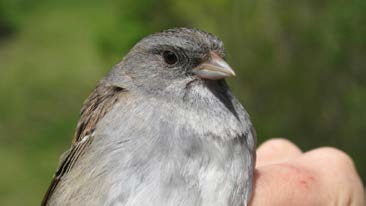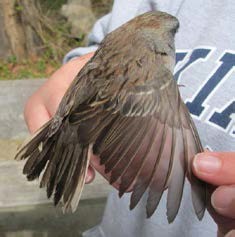Trevor Lloyd-Evans

White-throated Sparrow x Dark-eyed Junco hybrid. (All photographs by Alexandra Munters, Manomet Staff)
At 09:30 a.m. on May 8, 2014, staff of Manomet Center for Conservation Sciences—the Manomet Bird Observatory—mist-netted a hybrid White-throated Sparrow (WTSP, Zonotrichia albicollis) x Dark-eyed Junco (DEJU, Junco hyemalis) among 131 newly captured birds and 53 recaptures of previously banded birds. It was the busiest day of the season. At Manomet, this was a late record for migrant juncos; the two juncos banded previously were earlier, on April 17 and May 2. For Whitethroats, May 8 is in the peak migration period; we banded twelve new WTSP on May 6 (the maximum this season), five on May 7, six on May 8, six on May 9, and the last one on May 18.
The bird was hatched in 2013. It showed worn plumage and clearly retained juvenal flight feathers, primary coverts, and alula, contrasting with fresher greater coverts that had been renewed the previous fall (Pyle 1997). Overall, the upperparts were streaky and more brown than the illustration in Sibley (2000, p. 494), but washed with pale gray. The bird was healthy, with bulging subcutaneous fat, and had finished any pre-alternate molt. It had a fully ossified skull, a natural wing chord of 71 mm (2.8 in.), and weighed 22.5 g (0.79 oz.).

White-throated Sparrow x Dark-eyed Junco hybrid.
White-throated Sparrow-like Characteristics
The bird resembled a White-throated Sparrow in several ways, with a brown streaked mantle, white median covert tips (upper wing bar), and very worn pale greater covert tips (faint lower wing bar). Also, its head featured a faint gray median crown stripe with brown and black lateral crown stripes, as well as a white throat and black lateral border stripes. The iris was deep brown. The bird had a plump WTSP-shaped body and emitted a clear WTSP seeet call on release.
Dark-eyed Junco-like Characteristics
Like a Dark-eyed Junco, the bird had no rufous on its upper wing coverts and had a white belly. It had a gray supercilium and very dark lores; there was no pale eye ring. The bill was mostly pale. It had white outer webs on outer rectrices (R6) and a white tip on the inner webs, plus a white spot on the inner webs of rectrices R5. Its tarsus diameter was exactly junco size and notably slimmer than that of a Whitethroat, which takes a U.S. Fish & Wildlife Service’s band two sizes larger.
Measurements
The wing chord of 71 mm would be consistent with WTSP male (69–78) or female (64–72). It would also be consistent with the Slate-colored subspecies of DEJU (Junco h. hyemalis) female wing chord (69-77), but too short for SCJU male (73–82) from data in Pyle (1997). The mass (weight) of 22.5 g was consistent with Manomet’s spring WTSP weights for the last five years (18.7–39.2 g) but close to the top of the SCJU range (14.1–24.1 g).
Previous Records
Falls and Kopachena (1994) and Pyle (1997) note Dark-eyed Junco hybrids with White-throated Sparrow, and additionally White-throated Sparrow hybrids with Golden-crowned and Harris’s sparrows. Short and Simon (1965) report specimens or other convincing data for nine records of WTSP x DEJU from 1882–1964. These were from the Province of Ontario, Canada, and from New York, Connecticut, Pennsylvania (2), Maryland (2), Virginia, and Georgia. Jung et al. (1994) report an October 1991 male hybrid from Potomac, Maryland, that was kept in captivity until July 1992 and sang distinctive song parts from both WTSP and DEJU, although it was not clear whether these songs were genetically inherited or learned. The frontispiece of The Wilson Bulletin 106 (2): 1994 features a beautiful full-color painting of a White- throated Sparrow x Dark-eyed Junco by John C. Anderton.
E-bird records for this hybrid are noted in Ontario and Nova Scotia in Canada; in the United States, records are noted in Michigan, Ohio, Maine, Connecticut, New York, Pennsylvania, Virginia, North Carolina, Georgia, and Arkansas. A brief check of the Internet revealed a WTSP x DEJU photographed on November 20, 2011, in Brevard, North Carolina by Ed Peachey. Mark Szantyr shows a hybrid photographed by Bruce and Kevin Finnan in winter 1999 at Litchfield, Connecticut, and two he photographed himself on January 14, 2008, at Ashford, Connecticut.
A check of the main compilations for published literature in Massachusetts (Forbush 1929; Griscom and Snyder 1955; Veit and Petersen 1993) did not reveal any Massachusetts records of this hybrid. However, many authors specifically avoid the confusion inherent in records of hybrids. In the case of the Manomet bird, we have no reason to assume that the parents were other than a White-throated Sparrow and a Slate-colored Junco (WTSP x SCJU). However, there is equally no evidence to refute the possibility of other junco subspecies being a parent of this bird, so the record is
presented as a WTSP x DEJU hybrid. The bird was released without collecting samples for DNA analysis. There are many museum collections and electronic sources, plus other published records that I have not had the opportunity to check thoroughly. One of the purposes of this short paper is to solicit information on any Massachusetts records of such hybrids.
Many thanks to Alexandra Munters for the documentary photographs. The Manomet banding staff in spring 2014 were Mattie VandenBoom, Grace Alloy- Relihan, Lauren diBiccari, and Alexandra Munters, assisted on May 8, 2014, by volunteer banders Orla O’Brien and Patty O’Neill, whose hard work that day was justly rewarded. The migration banding program at Manomet is supported by generous contributions and volunteer time by members and friends.
References
- Falls, J. B., and J. G. Kopachena. 1994. White-throated Sparrow (Zonotrichia albicollis) in The Birds of North America No. 128 (A. Poole and F. Gill, Eds.). Philadelphia: The Academy of Natural Sciences; Washington, D.C.: The American Ornithologists’ Union.
- Forbush, E. H. 1929. Birds of Massachusetts and other New England States. Vol. 3. Norwood, Massachusetts: Massachusetts Department of Agriculture.
- Griscom, L. and D. E. Snyder. 1955. The Birds of Massachusetts. An Annotated and Revised Check List. Salem, Massachusetts: Peabody Museum.
- Jung, R. E., E. S. Morton, and R. C. Fleischer. 1994. Behavior and Parentage of a White- throated Sparrow x Dark-eyed Junco Hybrid. Wilson Bulletin 106 (2): 189-202.
- Pyle, P. 1997. Identification Guide to North American Birds. Part I. Bolinas, California: Slate Creek Press.
- Short, L. L. Jr. and S. W. Simon. 1965. Additional hybrids of the Slate-colored Junco and the White-throated Sparrow. Condor 67 (5): 438-42.
- Sibley, D. A. 2000. The Sibley Guide to Birds. New York: Knopf.
- Veit, R. R., and W. R. Petersen. 1993. Birds of Massachusetts. Lincoln, Massachusetts: Massachusetts Audubon Society.
Trevor Lloyd-Evans has directed the migration banding program for landbirds at the Manomet Bird Observatory, now part of the Manomet Center for Conservation Sciences in Plymouth, Massachusetts, since 1972. He has lectured and published on bird ecology and conservation biology, is a member and former President of the Nuttall Ornithological Club, a member and former Chair of the Massachusetts Avian Records Committee, and a proud long-term contributor of records to Bird Observer.